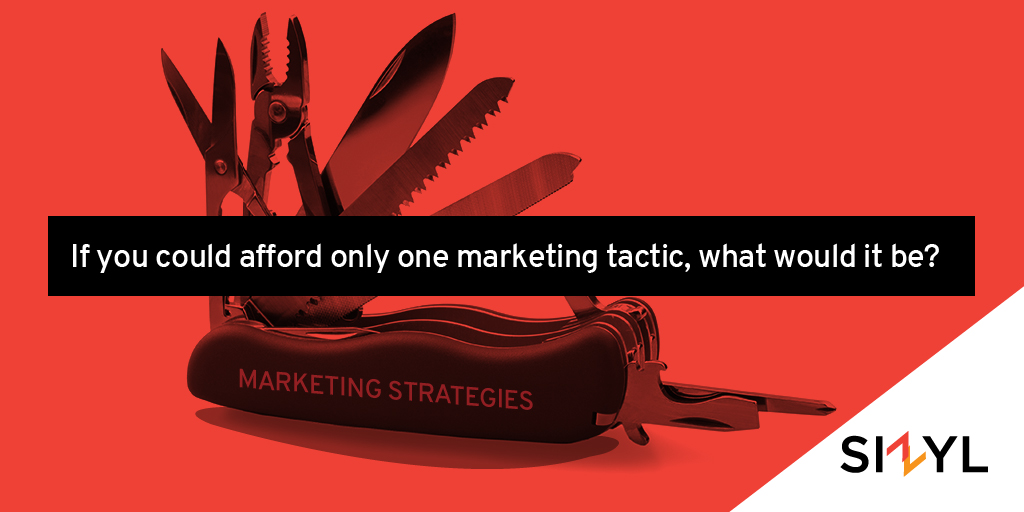I noticed on social forums people often ask about the best way to spend limited marketing funds. The questions are usually phrased “If I could afford to do only one marketing tactic, what would it be?”. This is an interesting question, as it assumes the most valuable things will come with a cost.
If everyone keeps asking, why doesn’t someone just answer? There no simple answer, and that’s the rub. The right marketing tactic depends on the business you’re in. Not all businesses are the same when it comes to marketing.
What’s really interesting, are some of the answers. Many marketers are one trick ponies. So of course, they think their one trick is the answer to everything. Put another way, if you’re a hammer the rest of the world looks like nails.
You run across a lot of marketing people who want to build you a website or optimize the site for SEO. Another group wants to write blog posts, while a third thinks Ads are the solution. Then there are the specialty people who offer custom videos or clever emails. They recommend all of this before they know the first thing about your business.
What the best marketing tactic investment?
I suspect by this point in this post you’re thinking: Is this guy going to answer the question? Yes, and here it goes. If you can only do one thing, do this:
Make sure you can describe your business and its value in 60 seconds or less.
Sort of anticlimactic, isn’t it? Hate to tell you this, but that’s the real answer. If you can’t easily articulate what you do, and why anyone needs it, you haven’t passed Go.
What marketing tactic comes next?
Now you’re thinking, I already know that. That’s business 101. What comes next? Next, you need to make sure you know your target audience. Who needs your product or service and why? You’d be amazed how many businesses haven’t stepped back and thought about this. How can you even begin thinking about marketing tactics, if you haven’t really thought this through?
Know Your Buyer’s Journey
OK, let’s assume you can articulate your value proposition and you know who needs it. What’s the next step? The next step is to know how they buy. I’m not talking about the purchase transaction I’m talking about the journey. From the time your target audience gets the thought they might need you, what are the things they do to find you?
SiriusDecisions did research on this several years ago and found the average customer will be 50% to 70% through the buyer’s journey before they will engage with a sales person. So what are they doing? And we’re back to it depends on the business you’re in.
They website/SEO marketer is jumping out of their chair right now yelling they do a search! That’s not always true. A few years ago, I was working with one of the top solar panel companies. They told me most people get interested because a neighbor installed panels. They found their best marketing tactic to be lawn signs, door hangers and vehicle wraps.
How did they get the first customer on the block? They knew their product had a great return on investment for someone living in a sunny State. They knew the early adopter was a highly educated environmentally conscious, economically well off home owner. This caused them to target specific communities and community groups that were trying to do something environmentally friendly.
The point here is they understood their value, understood their buyer and used really focused marketing tactics. None of the common ones that come to mind work for them. Placing Ads was just a waste of money. Search wasn’t the first thing their audience did. They weren’t trying to reach everyone, they had a highly targeted niche.
Their audience wasn’t going to begin their buyer’s journey by searching for solar panels. An educational approach was more compelling. It wasn’t really about the money saved as much as the environmental impact.
Hopefully, this example helps you understand why you need to know your value, target audience and their buyer’s journey before considering marketing tactics. You then need to map tactics to the journey. This usually takes a seasoned marketer as a guide.
If you have very limited funds to spend on marketing, and want to spend them wisely, build a foundation. Know your value proposition, target audience and their buyer’s journey, and avoid the one trick ponies. You’ll assume you can learn this by watching others in your market, but keep in mind that buyer’s journeys are changing. Those that recognize changes first are the ones that succeed and grow.

